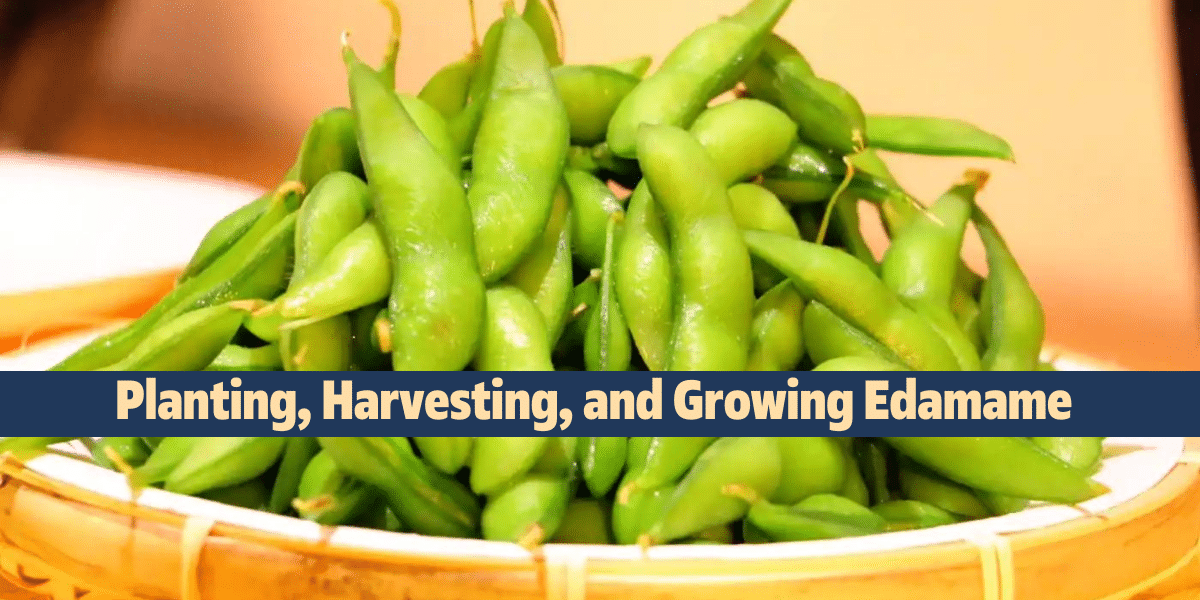Growing Edamame is a readiness of immature soybeans in the case, found in cooking styles with starting points in East Asia. The cases are bubbled or steamed and might be presented with salt or different sauces. In Japan, they are usually whitened in 4% salt water and not presented with salt. Soybeans are one of the world’s generally well-known healthy and adaptable food crops. They are handled into various food items, like soy protein, tofu, soybean oil, soy sauce, miso, natto, and tempeh. Let’s come down to next and know more detail about Planting, Growing, and Harvesting Edamame.
Overview of Edamame
Biological Name
Glycine max
Plant Type
Vegetable
Maturity Period
between 90 and 150 days
Maturity Size
2 to 3 inches long
Soil Type
Loamy
Soil pH
6.0
Exposure
Full Sun
Hardiness (USDA Zone)
3-9
Spacing
1-2 inches
Bloom Time
90 and 150 days
Toxity
Toxic if eaten raw
Flower Color
White
Growth Rate
90-150 days
Native Zone
East Asian
Maintenance
Edamame plants have fragile roots, so be careful not to harm them while weeding. Should Give water consistently to edamame plant throughout the season, even subsequent to blooming. Keep the dirt wet but not overwatered
History of Growing Edamame
Edamame is the name given to the youthful soybean unit. Once edamame cases develop, solidify, and dry, they are utilized to make soy milk and tofu. Edamame is usually steamed in water and afterward eaten by extracting the beans from its unit, popping straightforwardly into the mouth.
Albeit the expression “edamame” alludes to a technique for planting soybeans in Asian cuisine, where the cook momentarily bubbles entire units in salted water, Westerners frequently utilize the word reciprocally with soybeans (Glycine max). Edamame ages somewhere between 75 and 110 days after planting and need to be gathered while still youthful – no later than about fourteen days before the plant arrives at complete development.
Nutritional Facts Of Edamame
High in Protein
- Getting sufficient protein is urgent for ideal wellbeing.
- Veggie lovers and individuals who infrequently eat high-protein creature food sources need to give significant consideration to what they eat consistently.
- One concern is the generally low protein substance of many plant food sources. In any case, there are a couple of exceptional cases.
May Lower Cholesterol
- Observational investigations have connected strangely significant cholesterol degrees with an expanded danger of coronary illness (4Trusted Source, 5Trusted Source).
- One audit reasoned that eating 47 grams of soy protein each day can bring down complete cholesterol levels by 9.3% and LDL (the “awful”) cholesterol by 12.9%
Doesn’t Raise Blood Sugar
The individuals who eat loads of effectively processed carbs, like sugar, consistently are at an expanded danger of ongoing sickness.
- This is because quick assimilation and carb retention spike glucose levels, a condition known as hyperglycemia.
- Plentiful in Vitamins and Minerals
- Edamame contains high measures of a few nutrients and minerals, just as fiber.
Planting of Edamame
When To Plant Edamame
- Edamame requires a long-developing season.
- Like hedge beans, edamame develops from 1 to 3 feet tall and doesn’t commonly need marking.
- Plant in full sun in manure improved, all around depleted soil when temperatures reach in any event 60°F.
- Set seeds 1 to 2 inches down, 2 to 4 inches separated, in lines 2 feet separated.
- Amaze the planting time. Plant again around ten days after the first planting briefly gathers.
How To Plant Edamame
Edamame plants develop best when air and soil temperatures reach at any rate 60 to 70 degrees Fahrenheit, without the threat of ice. When your dirt is serviceable, you’re prepared to begin developing.
Plant seeds. Plant edamame seeds one to two inches somewhere down in your dirt, around three inches separated in the space of your nursery that gets full sun. Lines ought to be dispersed two feet separated.
Stun planting. For a ceaseless gather, sow seeds again at any rate ten days after the past planting.
Practice friend planting. Corn, squash, celery, and strawberries all make good allies for your edamame plant. Marigolds can help draw invaluable creepy crawlies that stop bothers like Mexican bean insects and whiteflies.
Growing of Edamame
Plant soybean seeds 1 to 2 inches (2.5-5cm) profound, 2 to 4 inches (5-1ocm) separated in columns 24 to 30 inches )61-76cm) separated. Slender fruitful seedlings from 4 to 6 inches (1015cm) separated; cutaway diminished seedlings with scissors at ground level, being mindful not to upset the foundations of residual plants. Try not to splash seed before planting and don’t overwater the following planting; too damp seeds may break and grow ineffectively.
Growing Edamame In Raised Bed
After all odds of ice have passed, plant edamame has passed, and average everyday temperatures arrive at the mid-70s° F.
Space edamame 12 to 18 inches separated in a space with plentiful sun and supplement rich, all-around depleted soil.
Improve local soil by blending in a few creeps of matured manure or other rich natural matter.
Growing edamame plants will require wet soil until they develop. Once settled, water them just when the top inch of soil is dry.
Keep your plants continuing forward by taking care of them routinely with water-solvent plant food.
Apply a layer of mulch produced using finely ground leaves or bark once plants arrive at 6 inches tall.
Harvest edamame when cases are light green and stout.
Growing Edamame In Container
- You can develop edamame in a pot because the plant develops just 1-3 feet tall.
- It just requires a pot that is 8-12 inches down and wide.
- It’s a late spring plant that develops well even in helpless soil; however, you have to give sufficient water to keep the dirt clammy.
Edamame Seedlings
The seedlings will arrive in a bit of pot that you need to remove and relocate to the bigger pot outside. It would help if you solidified the seedlings before you do this.
- Solidifying is an interaction where you assist the seedlings with becoming accustomed to the outside conditions, so they don’t get pushed when you relocate them. You do this by saving the seedlings outside for a couple of hours consistently.
- You can continue to do this for about a week, and the seedlings will have solidified and prepared for the transfer outside.
Pruning
- When you prune the plant, you remove portions of the plant, so it assists it with becoming better. This could be removing both dead or live pieces of the plant.
- You can cut the foliage, branches, and even cases of the plant that could be dead, sick, or even solid.
- The motivation behind pruning is so the plant can burn through more effort on developing blossoms and cases instead of on the foliage or dead parts. On the off chance that you prune the leaves when developing, the plant will develop more leaves.
- On the off chance that you prune the plant when creating blossoms, it will develop more blossoms.
Harvesting and Growing Edamame
Edamame units are prepared to gather when they are 2 to 3 inches in length, dazzling green and stout. Snap or cut the cases off the plant. Try not to tear the plant.
Store new edamame in a sealed shut holder or a plastic pack in the fridge.
Whitened edamame can be frozen shelled or in the units.
Reap dry soybeans when the plant and leaves are dry and earthy colored and the seeds inside the cases clatter. Pull up the plants and balance them in a dull and dry region until the cases are dry.
Store dried beans in a water/airproof holder in a dull, calm, and dry area.
Harvesting Soybeans For Edamame Seeds
- Search for a radiant green tone on the soybean cases. Like that of a pea pod, the rich green demonstrates that the edamame is prepared to gather.
- Review the cases for any yellow imprints. Yellow tints and streaks on the cases demonstrate that the edamame cases are past the ideal reap. The yellow tone creates when the beans foster starches that make them harder to process and eradicate the regular sweet flavor.
- Check the cases for general substance. Edamame arrives at its pinnacle flavor and supplements quality when the cases are 80 to 90 percent full.
- Handle the individual cases from the stem and pull delicately to eliminate them from the plant. Try not to crush the units, so you don’t harm the beans.
- Handle the foundation of the plant tail and pull it up tenderly to liberate it from the dirt and collect the whole plant on the double. Eliminate the cases independently once you pull the plant up, or hang the whole plant and dry the cases.
- Cut the foundation of the plant to the dirt surface with a couple of nursery trimmers. Drape it to dry the cases or pull each unit from the tail delicately.
Caring of Growing Edamame
Try not to deal with soybeans when they are wet or covered with substantial dew; this may spread organism spores.
Continue to plant beds without weed; develop around soybeans cautiously to not upset the plant’s shallow root framework.
Mulch to save soil dampness once the dirt has warmed. Pivot soybeans and different vegetables to add nitrogen to the dirt.
Edamame Recipe
1. Edamame pasta
2. One of the most loved recipes: Edamame spaghetti
3. Edamame noodles
FAQ
How long does Edamame take to grow?
Edamame can take anyplace somewhere in the range of 90 and 150 days from seed to unit. Edamame is prepared to collect when the units are dazzling green, loaded up with full seeds, and in any event a few inches in length.
Is Edamame easy to grow?
Edamame are extremely simple to develop, particularly in warm environments. Additional seeds make a decent transient summer cover crop
What zone does Edamame grow in?
Zone 9 nursery is edamame or soybeans. These plants love the warmth, are low-support, and very useful. Edamame are in the vegetable family, which implies the plants improve the dirt, a critical advantage for a natural vegetable nursery.
Can you plant frozen Edamame?
You can get frozen edamame at some Asian business sectors, however you presently additionally have the choice of becoming your own at home with the Edamame Growing Kit. … Your plant will develop to around 16 inches tall, growing the pea pods known as edamame.
Can you plant Edamame beans?
Plant edamame seeds one to two inches somewhere down in your dirt, around three inches separated in a space of your nursery that gets full sun. Lines ought to be dispersed two feet separated. Stun planting. For a consistent reap, sow seeds again at any rate 10 days after the past planting.
Should i soak Edamame seeds before planting?
Try not to splash seeds prior to planting. Plant seeds at a profundity of 1 inch, leaving space of 2 creeps inside lines while separating the lines 20 to 30 inches separated.

